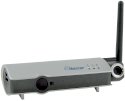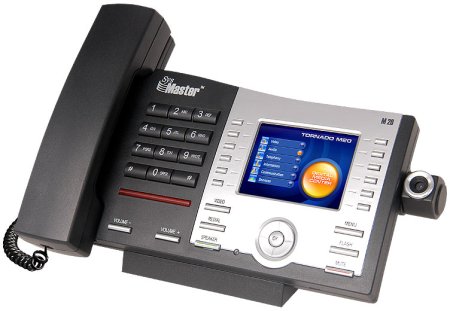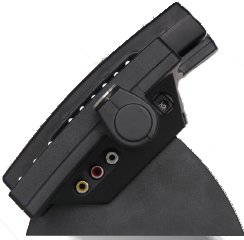Device Profile: SysMaster Tornado M20
Jun 15, 2007 — by LinuxDevices Staff — from the LinuxDevices Archive — 6 views SysMaster used embedded Linux to create a four-line IP (Internet protocol) video phone with built-in PBX and audio/video playback capabilities. The Tornado M30 can help network operators deliver voice or audio/video services to consumers and business users, according to the company.
SysMaster used embedded Linux to create a four-line IP (Internet protocol) video phone with built-in PBX and audio/video playback capabilities. The Tornado M30 can help network operators deliver voice or audio/video services to consumers and business users, according to the company.
 Tornado M10 (Click for details) |
SysMaster is best known as a vendor of VoIP billing software. It also sells several Linux-based wireless and IP-TV products capable of VoIP and videoconferencing, such as the feature-rich Tornado M10 set-top box (pictured at right).
The M10 and M20 appear to be based on a very similar hardware platform. Both devices can connect to televisions via analog RCA video and stereo audio ports. The M20 also has its own 3.5-inch color LCD display, along with a telephone keypad and handset.
The M20 connects to local networks via wired or wireless (802.11b) interfaces. Each of its four lines is said to have PBX software and “peer auto-discovery,” such that no central SIP server is needed, when used on the same LAN. The phone also supports standard SIP-based VoIP registrars, proxies, or outbound proxy servers, the company said.

SysMaster Tornado M20
(Click to enlarge)
Touted M20 features and capabilities include VoIP telephony, video conferencing, IPTV, video-on-demand, audio-on-demand, Internet radio, voicemail with local message storage, chat, email, news, and local weather information.
What's under the hood?
The M20 is based on a TI TMS320DM320 dual-core processor, which integrates a DSP core along with a 180MHz ARM9 core. The device has 32MB of RAM, as well as 32MB of flash memory.
 Input/output connections include:
Input/output connections include:
- Ethernet
- 802.11b
- RCA analog video and stereo audio out
- Headset port
- Microphone port
On the software side, the M20 runs a 2.6.19 Linux kernel. Its graphics framework comprises Microwindows running on a kernel framebuffer. Other open-source software includes FreeType, OpenSSL, and PNG and JPEG libraries.
The M20 measures 10 x 6 x 5 inches (254 x 172 x 140mm). It draws 2 amps of 5-Volt power, and comes with an external power adapter.
Martin Yosifov, director of marketing, said SysMaster chose Linux because of the company's “long history of success” using Linux in telecom products. “When it comes to choosing an operating system for embedded products such as the Tornado M20, Linux is a clear winner with its small footprint and low CPU load,” Yosifov said.
SysMaster used “very limited” commercial Linux support, largely creating and maintaining its own Linux port in-house, according to Yosifov. He added, “The largest problem that we faced was [our] dependence on a third party to develop the hardware. In our case it worked out well — we found a business partner whom we can trust, and heavily relied on its expertise to help us develop low-level device drivers and chip specific code.”
Asked for a prediction about Linux's future in the embedded market, Yosifov replied, “We believe Linux will expand its share in the embedded systems market because of its small footprint, reliability, and availability of software code.”
Availability
The M20 is available immediately, with a suggested retail price of $260.
This article was originally published on LinuxDevices.com and has been donated to the open source community by QuinStreet Inc. Please visit LinuxToday.com for up-to-date news and articles about Linux and open source.